Wikipedia:Picture of the day/September 2017
|
Featured picture tools: |
These featured pictures, as scheduled below, appeared as the picture of the day (POTD) on the English Wikipedia's Main Page in September 2017. Individual sections for each day on this page can be linked to with the day number as the anchor name (e.g. [[Wikipedia:Picture of the day/September 2017#1]] for September 1).
You can add an automatically updating POTD template to your user page using {{Pic of the day}} (version with blurb) or {{POTD}} (version without blurb). For instructions on how to make custom POTD layouts, see Wikipedia:Picture of the day.Purge server cache
September 1
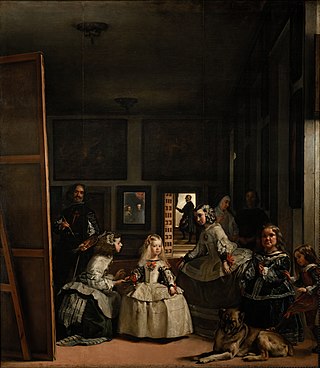
|
Las Meninas is a 1656 painting in the Museo del Prado in Madrid, by Diego Velázquez, the leading artist of the Spanish Golden Age. It shows a large room in the Royal Alcázar of Madrid during the reign of King Philip IV of Spain, and presents several figures, including the young Infanta Margaret Theresa surrounded by her entourage. Las Meninas has been recognised as one of the most important paintings in Western art history, and its complex and enigmatic composition has frequently been the subject of analysis. It has been described as "Velázquez's supreme achievement, a highly self-conscious, calculated demonstration of what painting could achieve, and perhaps the most searching comment ever made on the possibilities of the easel painting". Painting: Diego Velázquez
Recently featured:
|
September 2

|
A folio from an 8th- or 9th-century Quran, written in Kufic script during the Abbasid Caliphate. The central religious text of Islam, the Quran is believed by Muslims to have been revealed by God to Muhammad through the angel Gabriel. The Quran consists of 114 chapters (surah), each comprising a different number of verses (ayat). Shown in this folio is parts of Al-Fath (48), verses 27-28. Folio: Unknown
Recently featured:
|
September 3

|
Hafnium is a chemical element with the symbol Hf and atomic number 72. A lustrous, silvery gray, tetravalent transition metal, hafnium chemically resembles zirconium and is found in many zirconium minerals. Its existence was predicted by Dmitri Mendeleev in 1869, though it was not identified until 1923, making it the last stable element to be discovered. Hafnium is named for Copenhagen, where it was discovered. Photograph: Heinrich Pniok
Recently featured:
|
September 4

|
Young Knight in a Landscape is a painting by the Italian Renaissance artist Vittore Carpaccio. Dated 1510, it has been called the earliest full-length portrait in Western painting. The identity of its subject has been debated, with proposed sitters including the Duke of Urbino, Francesco Maria I della Rovere; as well as the Venetian patrician Marco Gabriel. It is now held by the Thyssen-Bornemisza Museum in Madrid. Painting: Vittore Carpaccio
Recently featured:
|
September 5

|
Cancer is a medium-size constellation and one of the twelve constellations of the zodiac. Its name is Latin for crab, and it is commonly represented as one. Cancer's stars are rather faint, with its brightest star Beta Cancri having an apparent magnitude of 3.5. It contains two stars with known planets. Located at the center of the constellation is Praesepe (Messier 44), one of the closest open clusters to Earth and a popular target for amateur astronomers. Cancer is shown here as depicted in Urania's Mirror, a set of constellation cards published in London in about 1825. Illustration: Sidney Hall; restoration: Adam Cuerden
Recently featured:
|
September 6
Subpage 1
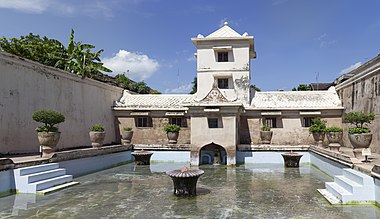
|
The tower and Umbul Pasiraman bathing complex at Taman Sari, the site of a former royal garden in Yogyakarta, Indonesia. It is located within the grounds of the palace of the city's sultan. Built in mid-18th century, Taman Sari historically consisted of four distinct areas. However, only the central bathing complex is well preserved today. See the west gate and east gate Photograph: Chris Woodrich
Recently featured:
|
Subpage 2

|
The west gate (Gedhong Gapura Hageng) at Taman Sari, the site of a former royal garden in Yogyakarta, Indonesia. It is located within the grounds of the palace of the city's sultan. Built in mid-18th century, Taman Sari historically consisted of four distinct areas. However, only the central bathing complex is well preserved today. See the central bathing complex and east gate Photograph: Chris Woodrich
Recently featured:
|
Subpage 3
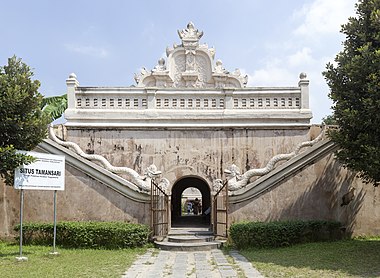
|
The east gate (Gedhong Gapura Panggung) at Taman Sari, the site of a former royal garden in Yogyakarta, Indonesia. It is located within the grounds of the palace of the city's sultan. Built in mid-18th century, Taman Sari historically consisted of four distinct areas. However, only the central bathing complex is well preserved today. See the central bathing complex and west gate Photograph: Chris Woodrich
Recently featured:
|
September 7

|
A malachite kingfisher (Corythornis cristatus) at Lake Baringo, Kenya. Although many male birds have brighter colours than females, this is not the case with the malachite kingfisher; both sexes are equally colourful. When fishing, these birds often perch less than a metre above the water, diving in once they spot fish, aquatic insects, or crustaceans to prey upon. Photograph: Charles J. Sharp
Recently featured:
|
September 8

|
Mary was a 1st-century Galilean Jewish woman of Nazareth, and the mother of Jesus according to the New Testament and the Quran. The gospels of Matthew and Luke describe Mary as a virgin, and Christians believe that she conceived her son while a virgin by the Holy Spirit. The birth of Jesus took place when Mary was already betrothed to Joseph and was awaiting the concluding rite of marriage. Mary has been venerated since Early Christianity, and is considered by millions to be the most meritorious saint of the religion. Mary is depicted here in The Virgin in Prayer, a 17th century oil painting on canvas by the Italian artist Giovanni Battista Salvi da Sassoferrato. Painting: Giovanni Battista Salvi da Sassoferrato
Recently featured:
|
September 9
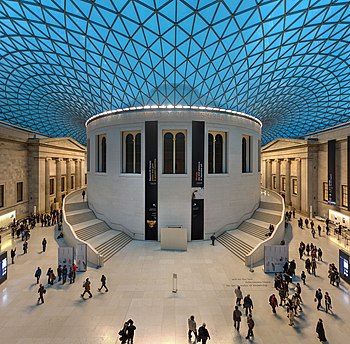
|
The Queen Elizabeth II Great Court is the central quadrangle of the British Museum in London. Based on a 1970s design by Colin St John Wilson, it was developed during the late 1990s by Foster and Partners after the British Library relocated to its own building. In its centre is the British Museum Reading Room, formerly the main reading room of the Library. The Court, covered by a tessellated roof, also includes twelve sculptures from the British Museum's collection. Photograph: David Iliff
Recently featured:
|
September 10
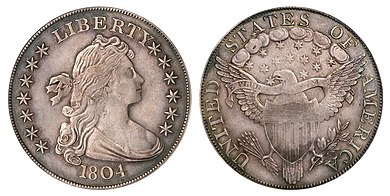
|
The 1804 dollar is a dollar coin struck by the Mint of the United States; despite the date on the coin, none were struck before the 1830s. First created for use in special proof coin sets used as diplomatic gifts during Edmund Roberts' trips to Siam and Muscat, several restrikes were ordered in the 1840s. Today, only fifteen specimens are known to exist, divided into three slightly different classes. The Class III example pictured is one of only six known, and sold in a 2009 auction for USD $2,300,000. Coin: Mint of the United States; photograph: Heritage Auctions
Recently featured:
|
September 11

|
Francis S. Thayer (1822–1880) was an American merchant and politician from New York. He served as a member of the New York State Senate from 1868 to 1871. He was the sole member of the Republican Party to vote against the Tweed Charter, through which Grand Sachem of Tammany Hall William M. Tweed consolidated power among his political allies. Photograph: Charles Burt; restoration: Andrew Shiva
Recently featured:
|
September 12

|
Kings' Fairy Tale, a painting by the Lithuanian painter, composer, and writer Mikalojus Konstantinas Čiurlionis (1875–1911) completed in 1908–1909. During his lifetime, Čiurlionis created about 300 paintings, composed about 400 pieces of music, and wrote many literary works and poems. Considered representative of the fin de siècle epoch, he contributed to the symbolism and Art Nouveau movements. Painting: Mikalojus Konstantinas Čiurlionis
Recently featured:
|
September 13

|
Thomas Müller (b. 1989) is a German professional footballer who has played for Bayern Munich since 2009; he is also the team's vice-captain. A versatile player, Müller plays as a midfielder or forward but has also been deployed in attacking roles such as attacking midfielder, second striker, centre forward and on either wing. He has represented Germany on its national team since 2010. Photograph: Michael Kranewitter
Recently featured:
|
September 14

|
Taractrocera ceramas, commonly known as the Tamil grass dart, is a butterfly belonging to the family Hesperiidae. It is found from the Western Ghats to Mumbai, in the hills of southern India and northern Burma. Taken at Kadavoor, Kerala, India. Photograph: Jeevan Jose
Recently featured:
|
September 15
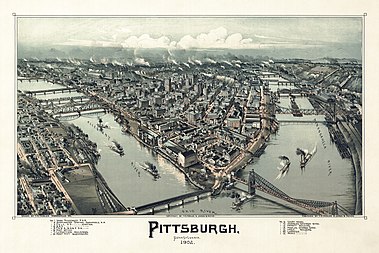
|
A bird's eye view of Pittsburgh, Pennsylvania, in a 1902 lithograph by Thaddeus Mortimer Fowler. At this point in its history, Pittsburgh was an industrial and commercial powerhouse, with extensive railroad connections to the rest of the United States. Together with the rest of Allegheny County, it produced massive amounts of steel and steel products: by 1911 they reached 24% of the national output of pig iron, 34% of Bessemer steel, 44% of open hearth steel, 53% of crucible steel, 24% of steel rail, and 59% of structural shape. Lithograph: Thaddeus Mortimer Fowler; restoration: Adam Cuerden
Recently featured:
|
September 16

|
The Shard is a 95-storey skyscraper in Southwark, London, that forms part of the London Bridge Quarter development. Standing 309.7 m (1,016 ft) high, the Shard is the tallest building in the United Kingdom. Designed by Renzo Piano and constructed between 2009 and 2012, it has 72 habitable floors, with a viewing gallery and open-air observation deck on the 72nd floor. Photograph: Colin
Recently featured:
|
September 17

|
A cassette recorder, produced and sold by RadioShack. Such portable tape recorders used Compact Cassettes to record audio using built-in microphones. This audio could then be played back on any cassette deck. Photograph: Evan Amos
Recently featured:
|
September 18

|
|
Act I, Scene I of King Lear, a play by William Shakespeare first performed in 1606, as depicted by Edwin Austin Abbey. Based on the legend of Leir of Britain, it depicts King Lear's gradual descent into madness after he disposes of his kingdom to two of his three daughters based on their flattery. This tragedy has frequently been adapted for the stage and motion pictures, with the title role coveted by many of the world's most accomplished actors. In this scene, Cordelia, the youngest of Lear's three daughters, is banished for refusing to profess her love in return for one third of the kingdom. Instead, she proclaims that there is nothing to compare her love to, nor words to properly express it. Painting: Edwin Austin Abbey
Recently featured:
|
September 19

|
A colour-composite image of the Carina Nebula, revealing details in the stars and dust of the region. Several astronomical objects can be seen in this wide field image, including the binary star Eta Carinae to the bottom left, adjacent to the Keyhole Nebula. Two open star clusters, Trumpler 14 and Collinder 228, can be found above and below Eta Carinae, respectively. Photograph: ESO
Recently featured:
|
September 20
|
Drainage of water in Lake Urmia in Iran between 1984 and 2014. Once the largest lake in the Middle East, with a surface area of approximately 5,200 km2 (2,000 sq mi), this salt lake has shrunk to less than 10% of its former size. Video: مانفی using NASA imagery
Recently featured:
|
September 21

|
Charlottenburg Palace is a large palace in Charlottenburg, a part of the Charlottenburg-Wilmersdorf borough of Berlin, Germany. The palace was built at the end of the 17th century and expanded during the 18th century. It includes much exotic internal decoration in baroque and rococo styles. It was badly damaged during the Second World War, but has since been reconstructed, becoming a major tourist attraction. Photograph: Thomas Wolf
Recently featured:
|
September 22

|
Echidna catenata, also known as the chain moray, is a species of moray eel found in shallow parts of the western Atlantic Ocean and the Caribbean. It is mainly nocturnal, hiding in holes and crevices in shallow water during the day. Although it may reach a maximum length of 165 cm (65 in), lengths of about 40 cm (16 in) are more common. Photograph: Betty Wills
Recently featured:
|
September 23

|
Breakfast Time is an oil painting on canvas completed in 1887 by the Swedish artist Hanna Pauli (1864–1940). Measuring 91 by 87 centimetres (36 by 34 in), it shows a dining table standing in the garden, set for breakfast. Since 1910, the painting has been held by the Nationalmuseum in Stockholm. Painting: Hanna Pauli
Recently featured:
|
September 24

|
A female cheetah (Acinonyx jubatus) on the Phinda Private Game Reserve, KwaZulu-Natal, South Africa. Cheetahs accelerate from 0 to 60 miles per hour (0 to 97 km/h) in less than 3 seconds and average 40 mph (64 km/h) during a chase. The species is classified as vulnerable, with only 7,000 left in the wild. Photograph: Charles J. Sharp
Recently featured:
|
September 25

|
William Faulkner (1897–1962) was an American writer and Nobel Prize laureate from Oxford, Mississippi. Although he wrote novels, short stories, a play, poetry, essays, and screenplays, he is primarily known for his works set in the fictional Yoknapatawpha County. Faulkner's work was published widely during the 1920s and 1930s, but he remained relatively unknown until receiving the 1949 Nobel Prize in Literature. Two of his works, A Fable (1954) and The Reivers (1962), won the Pulitzer Prize for Fiction. Today, Faulkner is one of the most celebrated writers in American literature. Photograph: Carl Van Vechten; restoration: Adam Cuerden
Recently featured:
|
September 26
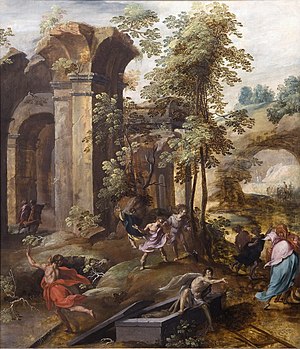
|
Elisha was a Hebrew prophet and a wonder-worker who is venerated in Judaism, Christianity, and Islam. According to the Books of Kings, he was anointed the successor of Elijah and served as the "prophet in Israel" for more than six decades. During this time, many miracles were attributed to him. Shown here is The Miracle at the Grave of Elisha, an oil painting on panel which was completed by the Dutch painter Jan Nagel in 1596. It depicts part of the Biblical account of Elisha, a miracle that occurred after his death. Following 2 Kings 13:21, the painting shows a dead man who was "revived, and stood up on his feet" after touching Elisha's interred bones. Painting: Jan Nagel
Recently featured:
|
September 27

|
Karang Bolong Beach is a white-sand beach on the island of Nusa Kambangan in Cilacap Regency, Central Java, Indonesia. Located on the eastern end of the island, inside a nature reserve, the beach is situated near an old Dutch fortress. Photograph: Chris Woodrich
Recently featured:
|
September 28

|
|
A panoramic view of Toledo, as seen from the Parador Hotel in 2014. This central Spanish city is the capital of the province of the same name. It was declared a World Heritage Site by UNESCO in 1986 for its extensive cultural and monumental heritage. It has historically been influenced by the co-existence of Christians, Muslims and Jews. As of 2015[update], the city has a population of 83,226 and an area of 232.1 km2 (89.6 sq mi). Photograph: Chensiyuan
Recently featured:
|
September 29

|
The ballistic missile submarine HMS Vanguard, lead ship of her class, arrives at HMNB Clyde in Faslane, Scotland, following a patrol in 2010. Ballistic missile submarines like Vanguard were introduced during the Cold War, and serve as the third leg of the nuclear triad in countries which also operate nuclear-armed land-based missiles and aircraft. Their intended role in the nuclear triad is to provide a second-strike capability in a defensive capacity, or to offer nuclear-armed nations a first-strike weapons platform. In addition to the first- and second-strike capabilities, Vanguard carries a handwritten letter from the Prime Minister of the United Kingdom which contains orders on what action to take in the event that an enemy nuclear strike has destroyed the British government. Photograph: Tam McDonald
Recently featured:
|
September 30

|
Frederick Roberts, 1st Earl Roberts (1832–1914), was a British soldier who was one of the most successful commanders of the 19th century. He served in the Indian Rebellion, the Expedition to Abyssinia, and the Second Anglo-Afghan War before leading British Forces to success in the Second Boer War. He also became the last Commander-in-Chief of the Forces before the post was abolished in 1904. Painting: John Singer Sargent
Recently featured:
|
Picture of the day archives and future dates
